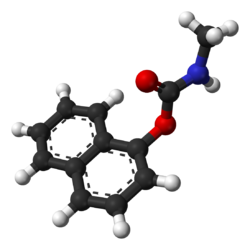| |||
| Names | |||
|---|---|---|---|
| Preferred IUPAC name Naphthalen-1-yl methylcarbamate | |||
| Other names | |||
| Identifiers | |||
3D model (JSmol) | |||
| ChEBI | |||
| ChEMBL | |||
| ChemSpider | |||
| ECHA InfoCard | 100.000.505 | ||
| EC Number |
| ||
| KEGG | |||
PubChem CID | |||
| RTECS number |
| ||
| UNII | |||
| UN number | 2757 | ||
CompTox Dashboard (EPA) | |||
| |||
| |||
| Properties | |||
| C12H11NO2 | |||
| Molar mass | 201.225 g·mol−1 | ||
| Appearance | Colorless crystalline solid | ||
| Density | 1.2 g/cm3 | ||
| Melting point | 142 °C (288 °F; 415 K) | ||
| Boiling point | decomposes | ||
| very low (0.01% at 20°C) [1] | |||
| Pharmacology | |||
| QP53AE01 ( WHO ) | |||
| Hazards | |||
| GHS labelling: | |||
    | |||
| Danger | |||
| H301, H302, H332, H351, H410 | |||
| P201, P202, P261, P264, P270, P271, P273, P281, P301+P310, P301+P312, P304+P312, P304+P340, P308+P313, P312, P321, P330, P391, P405, P501 | |||
| Flash point | 193-202 [1] | ||
| Lethal dose or concentration (LD, LC): | |||
LD50 (median dose) | 710 mg/kg (rabbit, oral) 250 mg/kg (guinea pig, oral) 850 mg/kg (rat, oral) 759 mg/kg (dog, oral) 500 mg/kg (rat, oral) 150 mg/kg (cat, oral) 128 mg/kg (mouse, oral) 230 mg/kg (rat, oral) [2] | ||
| NIOSH (US health exposure limits): | |||
PEL (Permissible) | TWA 5 mg/m3 [1] | ||
REL (Recommended) | TWA 5 mg/m3 [1] | ||
IDLH (Immediate danger) | 100 mg/m3 [1] | ||
| Safety data sheet (SDS) | ICSC 0121 | ||
Except where otherwise noted, data are given for materials in their standard state (at 25 °C [77 °F], 100 kPa). | |||

Carbaryl (1-naphthyl methylcarbamate) is an organic compound with the formula C10H7OC(O)NHCH3. Classified as a carbamate, it is used chiefly as an insecticide. It is a white solid was under the brand name Sevin, which was a trademark of the Bayer Company. [3] [4]

